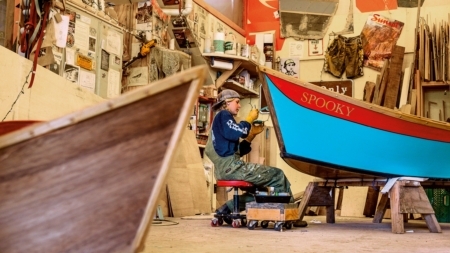Bound for Dory
A colorful tradition of building and running Grand Canyon dory boats is passed to the next generation.
On a cold winter night in Flagstaff, Arizona, when big whitewater and leisurely floats down the Grand Canyon feel far away, the lights are on in an eclectic wood shop called Fretwater Boatworks. Inside, amidst an organized chaos of hand tools, power tools, lumber and a sign on the wall that reads, “You can’t beat this place for fun,” a carpenter and his apprentice are putting the finishing touches on a traditional Grand Canyon dory boat. For a moment, the mood feels serious, tense, even. Brad Dimock runs a calloused hand along the gunnels. His sawdust blond hair stands up as if the room is electric and he squints his eyes as he beholds his apprentice’s work. Then he smiles and says, “That’s a beautiful boat, Cricket. Good job.”
Twenty-four-year-old Amy “Cricket” Rust got her nickname when she was a little girl growing up in Julian, California. She was trying to teach herself to whistle like her hero, John Wayne, but didn’t have anyone around to teach her. So she started sucking in instead of blowing, which made a sound closer to a cricket than the Duke.
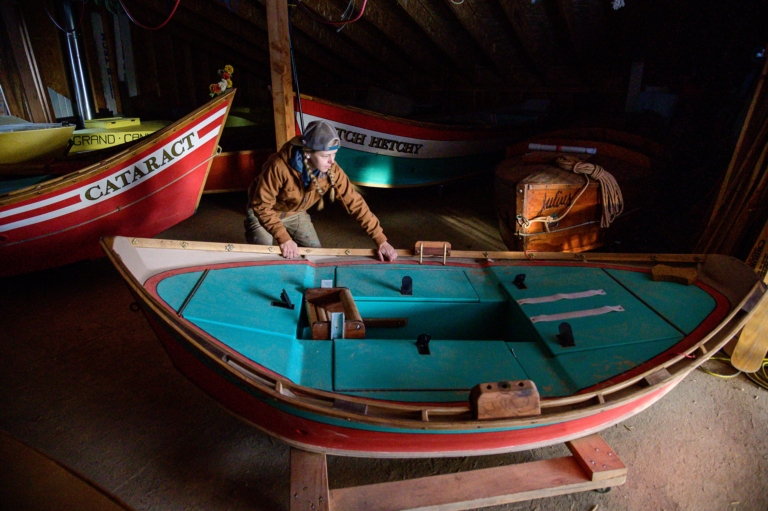
Cricket examines the ash gunnels, a wood that’s hard and resilient with the right amount of flex. Photo: Dawn Kish
Cricket picked up woodworking and cabinetry skills by helping her uncle build homes and hanging out in his shop. She saw her first Grand Canyon dory floating by Redwall Cavern (a section of the Grand Canyon) when she was on a trip to the Grand Canyon in high school. “I was enamored,” she recalls. “I was asking the boatman, ‘Can I touch it, can I look in it, can I sit in it?’ Once I started learning about dories and Martin Litton and their purpose and what they’ve done and seen and how many times they’ve been destroyed and still go down the Grand Canyon … I was obsessed. They’re beautiful, but they also put in a lot of work and many of the boats that have been there since the beginning are still there.”
Five years ago, Cricket was working for a Grand Canyon guide company and expressed interest in learning how to build and work on the boats. “They wouldn’t let me,” she recalls. “They said, ‘Once you’re done packing these sleep kits, you can work on the boats.’” But the sleep kits never ended. Dimock caught wind of this and approached her at Blacktail Canyon. “I heard those boys won’t let you work on the boats,” he said. “Do you want to come build them?” She arrived at Fretwater the next day.
Evolved from European, self-righting row boats that were designed for fishing in heavy ocean conditions, the dory eventually made its way west to Oregon’s Mackenzie and Rogue Rivers. But the tradition of Grand Canyon dories begins with one man: Martin Litton (1917–2014). He was on the rowing crew at UCLA before he first floated a section of the Colorado River, in 1952. He fell in love with the river and the canyon, but was nonplussed by the fiberglass boats of the time. They were “not very good boats,” he recalled in a 2012 interview with OARS (a whitewater outfitter company).
Since floating the Grand Canyon was less about carrying one or two anglers and more about multiweek expeditions with several passengers and their gear, Litton realized that a design upgrade was in order. Drawing on prior advancements, he made his dories shorter and fatter, which provided more stability without sacrificing responsiveness, nimble grace and the ability to pivot in big rapids. “This happened in every sport there is that involves gravity,” Dimock notes about Litton’s design. “Skiing, surfing, snowboarding—everything starts getting shorter and fatter, and it’s still happening.”
By introducing dories to the Grand Canyon, Litton not only created a tight-knit community of dory enthusiasts that still exists, but also established what would become an iconic vehicle in the fight to save sections of the Colorado River from being dammed. When Litton learned about megadam proposals for Marble and Bridge Canyons, he started naming his dories after dammed rivers and delivered an impassioned speech before the Sierra Club that convinced them to launch campaigns against the dam projects. In response to their pressure, Congress terminated both projects in 1968.
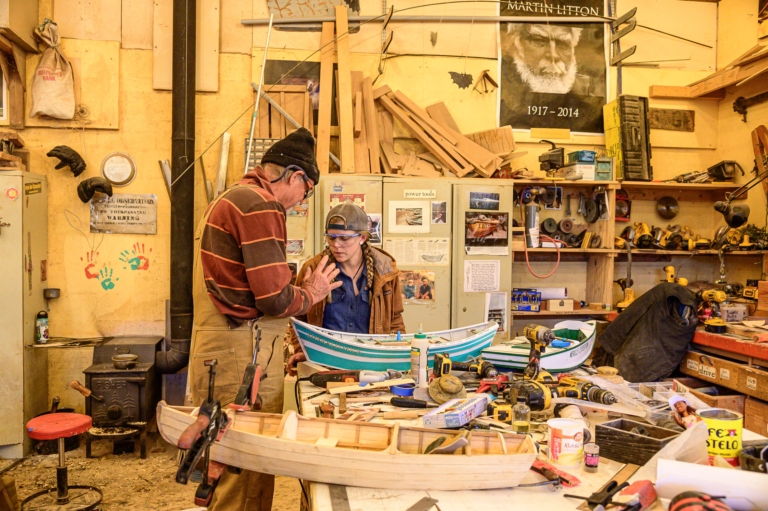
Three generations of dory love under one roof. Photo: Dawn Kish
Litton continued rowing and fighting to keep rivers wild and free for the rest of his life and, at the age of 87, became the oldest person to row the entire Grand Canyon. He also worked alongside Edward Abbey, David Brower and others to protest the construction of the Glen Canyon dam. “We could have stopped Glen Canyon Dam and we didn’t,” he told OARS in 2012. “But we didn’t try hard enough.” Unlike Abbey, whose primary weapon was the pen, Litton chose action to defend wilderness. His philosophy was to get more folks on the river and let them see for themselves what needed protecting. One of those folks was a young kayak racer and carpenter from Ithaca, New York, named Brad Dimock.
Today, while sitting inside a newly minted dory in Fretwater Boatworks, Dimock recalls Litton’s legacy: “He made us row across Lake Mead [for two days] so that people would get their noses rubbed in what a reservoir does to a living river and go home and care more.” Dimock worked for Litton’s boat company, Grand Canyon Dories, for seven years rowing a boat called Chattahoochee. After Litton had sold the company, and Chattahoochee along with it, Dimock learned that the boat had made its way back to Litton’s yard in a state of disrepair and was gathering weeds. When he asked if he could buy it and fix it up, Litton replied, “Well, I’d love to sell you that boat, but I can’t. I can’t sell a man his own boat. Get it out of my yard and take the trailer with it.”
Dimock didn’t know how to fix boats yet, so he added a fresh coat of paint, renamed it Cataract, took it out the next year and promptly “blew it into a million pieces.” Rebuilding Cataract is when his passion for fixing and repairing dories started in earnest. “She’s been my girl ever since,” he says.

Fretwater Boatworks runs entirely on solar power. Dimock built it out of wood, including the floor, which is useful for bracing and nailing things on-the-fly. It also keeps the sound level down when working with power tools and is easy on the feet and back. Photo: Dawn Kish
A self-described polyglot of techniques, Dimock has studied Viking ships, traditional Japanese boats and worked with boatbuilders across the United States. He picks and chooses his favorite techniques and applies them to the Grand Canyon dories he builds. “I’m not a traditionalist,” he says. “But I’m building really traditional boats in very innovative ways.” He also makes it clear that he’ll close up shop if it ever starts feeling like a job. “I don’t know what I’m doing next,” he says. “Probably something to do with the Grand Canyon, boats and the community, though.”
Hammer, chisel, duct tape, screwdriver, saw; these are the tools in Dimock’s river kit, but back at the shop, it’s a whole other story. “I’ve probably spent $3,000 on screws this year,” he says. “Silicon, bronze slotted wood screws which are very hard to find. We’re running out of batteries for the power tools. We’ve exploded all the blades to cut bronze, so we’re buying new blades. I use self-sealing heat-activated solder connectors for underwater wiring and bilge pumps and switches. I’ve probably spent $500 in fancy boat hinges this year. I have to buy weather stripping by the crate and we go through mountains of sand paper. I buy traditional marine paint from New Bedford, Massachusetts. It goes on and on. Lots of tools, lots of wood.”
To build the frames for his boats, Dimock sources Port Orford cedar from a sustainably managed forest. “It’s super rock resistant,” he says. “It smells beautiful, doesn’t splinter much, bends well—the Japanese buy it to build temples, so it’s holy.” For the gunnels and oars, he prefers ash wood because it’s hard and resilient with the right amount of flex. “[Ash] is quickly going extinct due to the Emerald ash borer,” he notes. “So we’re stocking up on it.” He also uses high-grade marine plywood from Indonesia.
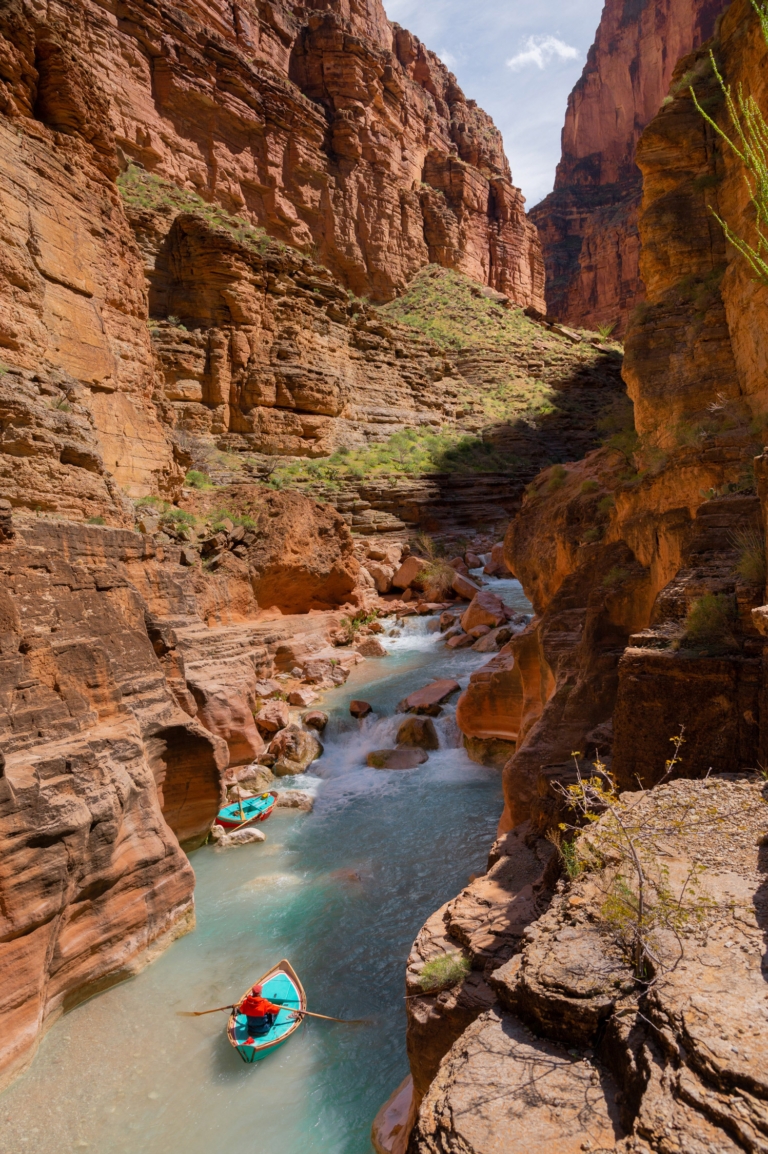
Dimock testing out one of his self-designed doryaks (a cross between a dory and a kayak) in the Grand Canyon. Photo: Dawn Kish
“We’re not building Steinways here, you know,” Dimock says about their work. “We’re building boats. They’re gonna go out and crash and get rebuilt, crash and get rebuilt. We want to build them right, but we also want to get them done, get them on the water, get on the water ourselves and build another boat.” Along with conservation history, lore and craft, Dimock is passing along a work ethic to Cricket that’s rooted in getting the job done and having fun along the way, while all the time trying out new approaches. “If you understand what you’re doing,” he likes to say, “you’re not learning. We never do the same thing twice around here.”
Cricket attributes Dimock’s trust in her work, improvisation and experimentation to her growth as a carpenter. Since her first day in the shop, which she calls home, Dimock has never chastised her for making a mistake. Instead, he says, “We can fix it.” This calm but focused approach has enabled Cricket to find better, more efficient techniques to get the job done, and Dimock relishes the moments when the student has surpassed the teacher.
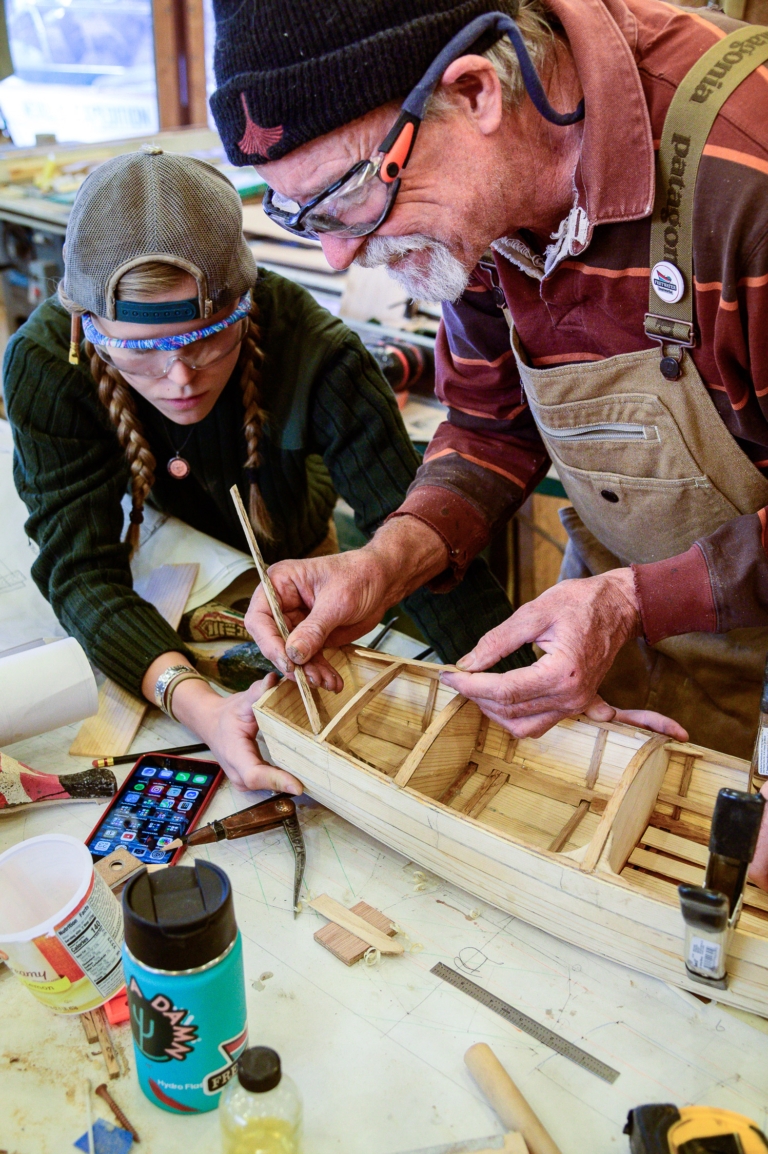
Dimock and Cricket also build replicas of iconic dories at 1/6 scale. It honors the boats and also allows them to hone building techniques before applying them to larger projects. Photo: Dawn Kish
“I just adore her,” Dimock says about Cricket. “She’s like the daughter I never had. It’s super exciting for me to have someone who is that interested in the heritage, stories, craft, beauty and tradition of the boats, but still is constantly trying to think of new ways to do things. She’s a wonderful apprentice, she’s a sweet person, very talented, very devoted to the craft and I hope she sticks with it. Both my apprentices are going to boat school this year to learn some of the traditional ways of doing things from the great masters, and they’re gonna come back and mess with me. And I love it.”
It’s well past quitting time at Fretwater, but, like most nights, Dimock and Cricket stick around to fuss over the intricacies of design or to drink beer, laugh and make plans for the spring/summer river season.* On some nights, local musicians play in the shop and friends old and new gather to watch slide shows and movies about river running. But tonight, it’s cold and quiet. Seventy-five miles to the northwest, beyond the high desert peaks and plateaus of the Kaibab National Forest, the Colorado River wends its way through the Grand Canyon. The taut silence of the calm stretches, the cacophony of Lava Falls Rapid and the spirit of Martin Litton carry on and inhabit the dreams of this carpenter and his apprentice. And the boats that will likely outlive their creators sit drydocked on sawhorses, eagerly awaiting the freedom of doing what they were built to do.
Cricket points to a dory named Hetch Hetchy. “She’s 51 years old now,” she says. “And she’s seen a lot, she’s been put through the wringer and she’s still floating. She’s still making Grand Canyon trips. It’s the longevity of them, they’re pieces of history that you get to row and be part of.
“In our little community in Grand Canyon, oral tradition is everything,” Cricket muses. “And all those names [that came before us], they all have different stories that are being told by different people with different inflections; I hope I can just keep up the tradition.”
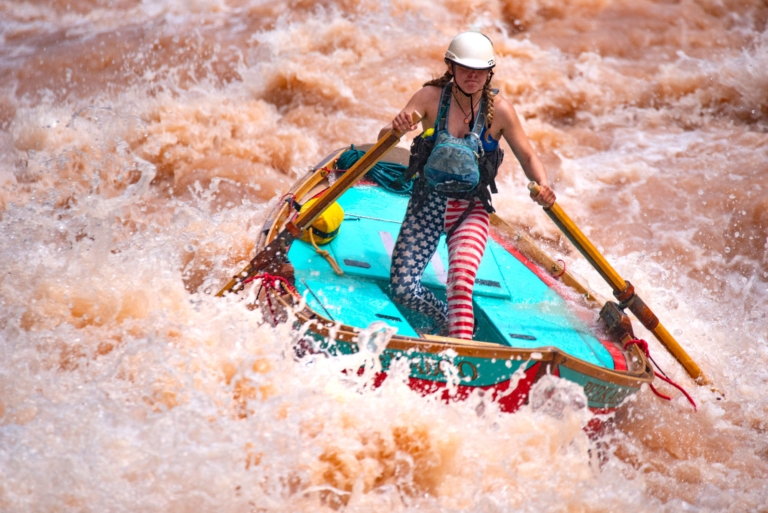
Cricket runs the Grand Canyon’s Lava Rapid in Peekaboo, a doryak she built at Fretwater Boatworks. Photo: Dawn Kish
*On March 24, Dimock posted on Instagram about the first run of what was expected to be another season of fun under the sun for the Grand Canyon dory community: “Doryaks rocked Grand Canyon. Zero flips and 100% permagrins.” Two days later, he posted: “Home from the river to meet the Scared New World.” During the pandemic, Dimock and Cricket have managed to get a few socially-distant floats in and build more boats. He also decluttered his closet.
